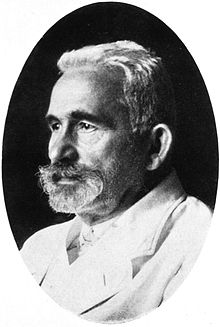
Back إميل كريبيلن Arabic اميل كريبيلن ARZ امیل کریپلین AZB Эміль Крэпелін Byelorussian Емил Крепелин Bulgarian এমিল ক্রেপেলিন Bengali/Bangla Emil Kraepelin Catalan Emil Kraepelin Czech Emil Kraepelin Danish Emil Kraepelin German
Emil Kraepelin | |
|---|---|
 Emil Kraepelin in his later years | |
| Born | 15 February 1856 |
| Died | 7 October 1926 (aged 70) |
| Nationality | German |
| Alma mater | Leipzig University University of Würzburg (MBBS, 1878) Ludwig Maximilian University of Munich (Dr. hab. med., 1882) |
| Known for | Classification of mental disorders, Kraepelinian dichotomy |
| Spouse | Ina Marie Marie Wilhelmine Schwabe[1] |
| Children | 2 sons, 6 daughters[1] |
| Scientific career | |
| Fields | Psychiatry |
| Institutions | Leipzig University University of Dorpat University of Heidelberg Ludwig Maximilian University of Munich |
| Thesis | The Place of Psychology in Psychiatry (1882) |
| Signature | |
Emil Wilhelm Georg Magnus Kraepelin (/ˈkrɛpəlɪn/; German: [ˈeːmiːl 'kʁɛːpəliːn]; 15 February 1856 – 7 October 1926) was a German psychiatrist. H. J. Eysenck's Encyclopedia of Psychology identifies him as the founder of modern scientific psychiatry, psychopharmacology and psychiatric genetics.
Kraepelin believed the chief origin of psychiatric disease to be biological and genetic malfunction. His theories dominated psychiatry at the start of the 20th century and, despite the later psychodynamic influence of Sigmund Freud and his disciples, enjoyed a revival at century's end. While he proclaimed his own high clinical standards of gathering information "by means of expert analysis of individual cases", he also drew on reported observations of officials not trained in psychiatry.
His textbooks do not contain detailed case histories of individuals but mosaic-like compilations of typical statements and behaviors from patients with a specific diagnosis. He has been described as "a scientific manager" and "a political operator", who developed "a large-scale, clinically oriented, epidemiological research programme". He developed racist, psychiatric theories.[2][3]
- ^ a b Cite error: The named reference
HGLwas invoked but never defined (see the help page). - ^ Engstrom, E. J. (1 September 2007). "On the Question of Degeneration' by Emil Kraepelin (1908)1" (PDF). History of Psychiatry. 18 (3): 389–398. doi:10.1177/0957154X07079689. PMID 18175639. S2CID 46482747. Archived from the original (PDF) on 26 May 2013..
- ^ Shepherd, M. (1 August 1995). "Two faces of Emil Kraepelin". The British Journal of Psychiatry. 167 (2): 174–183. doi:10.1192/bjp.167.2.174. PMID 7582666. S2CID 37204909.